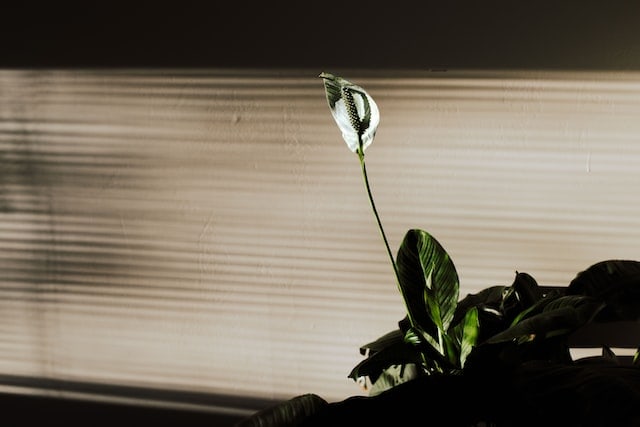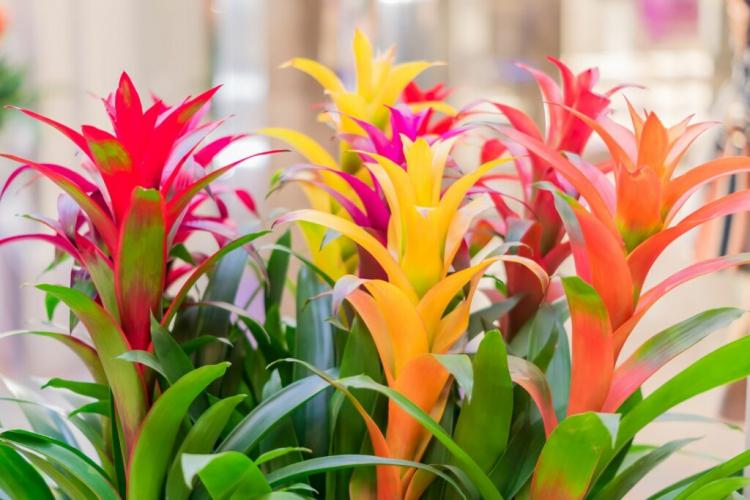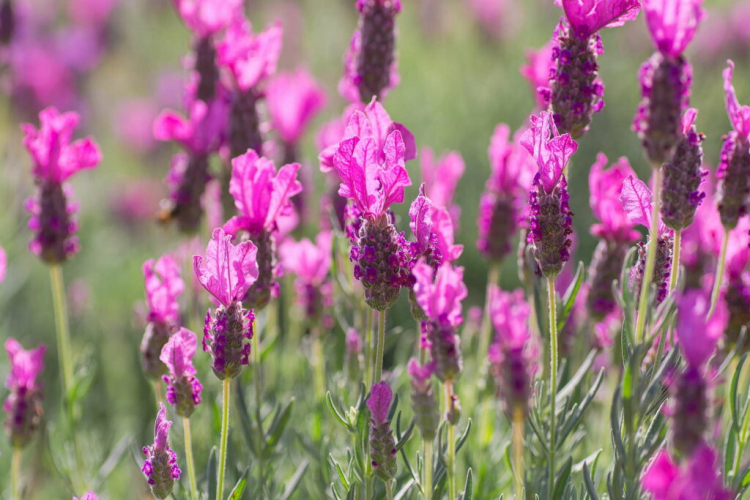Boxwood: Expert Tips On Evergreen Boxwood
Hardly any other evergreen plant is as popular with us as the boxwood. Here you can find out what you need to consider when planting, cutting.
Box trees ( Buxus ) have become an integral part of our garden landscape. As a hedge, bush, ball, or even in imaginative shapes, box trees decorate gardens and parks. In order for your box tree to thrive, there are a few things to keep in mind. With us, you can find out everything from planting and caring to propagation to wintering of the evergreen shrub.
Boxwood: origin and demands
Table of Contents
The name “boxwood” is derived from the Greek word “pyxís”, which means “Büchse” in German (English “Box Wood” – from “Box”). Because even in ancient Greece cans and cans were turned from the wood of the boxwood. The boxwood family (Buxaceae) includes 70 species worldwide.
The boxwood is a shrub that can also occur as a tree. The leaf dress is evergreen and consists of dark green, leathery leaves. The box tree makes little demands on its location and is otherwise very easy to care for. He also copes very well with frequent cutting. However, the evergreen bush grows very slowly, just 10 to 20 centimeters in a year.
Buy boxwood
When buying your box tree, you should make sure that the plant looks healthy and well cared for. Make sure you don’t find any signs of disease or pests on the boxwood. In addition, the foliage should be rich and green. The root must also be checked for its health. You can buy box trees in garden centers, hardware stores, or tree nurseries. Many online retailers also offer box trees for shipping.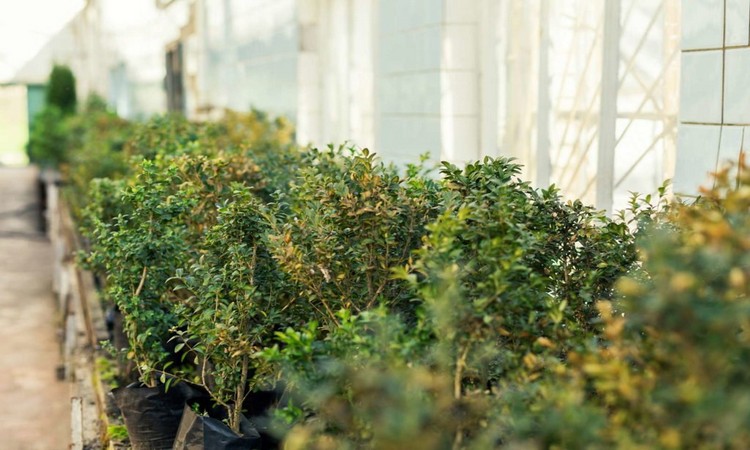
Boxwood species and varieties
Two types of boxwood ( Buxus ) are interesting for cultivation in our gardens: Buxus sempervirens and Buxus microphylla. Buxus sempervirens is the common boxwood and native to the Mediterranean. Buxus microphylla, the Japanese or small-leaved boxwood, originally comes from Korea and has also been grown in Japan for centuries. Below we introduce you to popular varieties of these two types.
Buxus sempervirens :
- ‘Suffruticosa’: The variety that is best for edging flower beds and as a hedge. It forms long, medium-sized, light green leaves and usually does not grow taller than 50 cm
- ‘Blauer Heinz’: This variety is also suitable as a border, as it is low-growing and frost-hardy. The leaves are bluish in color
- ‘Aurea’: This type of boxwood is interesting because of its special leaf color. After sprouting, the leaves are golden yellow and later turn green
- ‘Globosa’: If you want a boxwood ball, you should choose this variety; this grows a bit spherical by itself
Buxus microphylla:
- ‘Faulkner’: A popular variety of Buxus mircophylla. This has shiny, olive-colored leaves and is very resistant to drought and cold. Faulkner box trees grow very bushy and are therefore well suited as ground cover
- ‘Herrenhausen’: Another tried and tested boxwood variety. This is particularly suitable for hedges and borders is rather small, and resistant to fungal attack

Planting boxwood: location and instructions
The frugal box tree is satisfied with almost all locations, but you should consider a few points in order to create ideal growing conditions. The ideal location for your boxwood should be sunny and warm. The box tree especially loves locations with morning and evening sun. On the other hand, he doesn’t want to stand in the blazing midday sun. The soil should be well loosened and ventilated. You should avoid waterlogging by working sand into soil that is too heavy. Slightly moist, alkaline soils with a pH value between 6.5 and 7.5 offer ideal conditions for your boxwood.
Box trees feel particularly at home in this location:
- Sunny to a partially shaded location
- Loose, well-ventilated soil
- Soil rich in humus
- PH value between 6.5 and 7.5
The optimal time to plant the boxwood is in spring between March and May. Dig a sufficiently large planting hole. Now put the boxwood in the middle of the hole, then fill up the hole with the excavated material. When planting as a hedge, a spade-wide trench is drawn and the box trees are planted at a distance of 20 centimeters for low hedges and 30 to 35 centimeters for high hedges.
Planting boxwood: how to proceed step by step:
- Dig the planting pit
- Place the boxwood in the center of the planting hole
- Fill the planting pit with excavated material and compost
- Pouring on
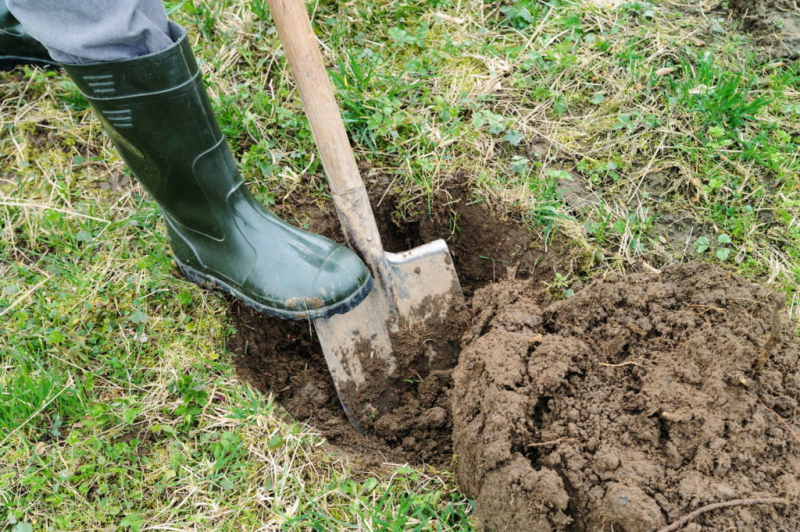
Transplant boxwood
You can also transplant box trees when they are old. To do this, choose a frost-free, not too hot day. To dig out the boxwood, you should use a spade to dig up the root ball to the same extent as the crown of the boxwood. The depth depends on the size of the tree – at least 40 centimeters for a small bush, at least 60 centimeters for a large one. Use a digging fork to loosen the soil under the bush as much as possible. Then lift out the boxwood and cut back any damaged roots. After that, the excavated boxwood should be watered in a vessel for half an hour. Then, as described above, it can be planted in its new location or in a pot.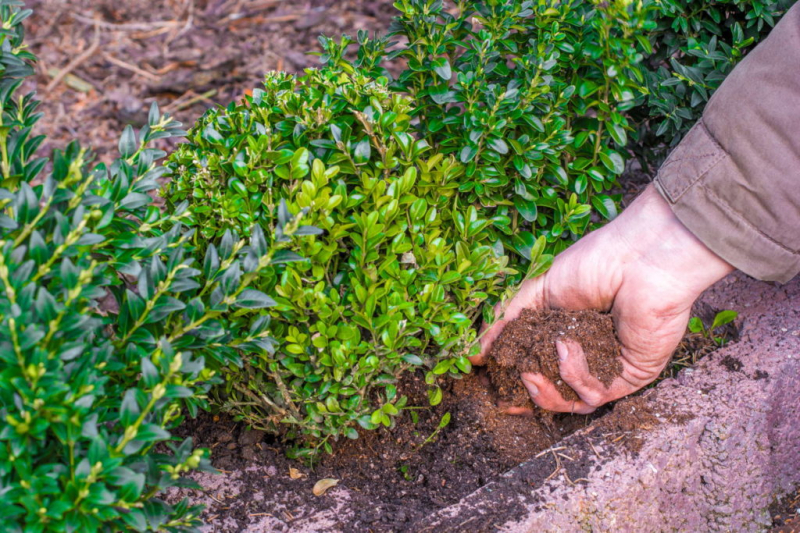
Propagate boxwood
There are two vegetative methods for your own propagation of box trees: propagation by cuttings or by division. We will introduce both of them to you below.
You might so like: Propagate Rubber Tree: Professional Tips For Propagation By Cuttings
Propagate boxwood with cuttings
The best time to propagate by cuttings is in late summer or autumn. Strong, bushy plants are best suited, from which older, branched shoots can be used. But you can also use younger plants for propagation.
The propagation of the boxwood by cuttings in a nutshell:
- Tear off approximately 15 centimeters long biennial shoots against the direction of growth
- Shorten shoot tips by a third
- Remove leaves from the lower third of the branch
- Cut off protruding bark tongue
- Plant in pots with cutting soil up to the base of the leaves
- Pour on and keep constantly moist
- Let grow at room temperature
- Transplant to the field next year
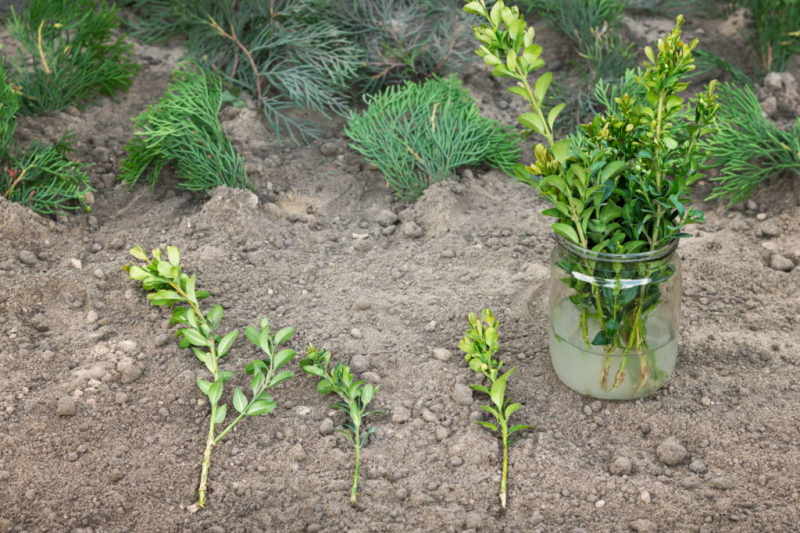
Propagate boxwood by dividing it
When dividing a box tree is cut and divided into two parts. However, this is associated with a high risk of loss, since entry points for diseases and pests arise as a result of the division. In addition, fewer young plants are obtained in this way than with cuttings.
Multiplying boxwood by dividing – summary:
- Cut out the plant generously around the root ball (radius is at least the current height of the tree)
- Divide the bale with a spade or saw on a hard surface
- The new partial plant should have at least two shoots
- Planting either outdoors or in pots
You might so like: Fertilize Magnolia: When, How And Which Fertilizer?
Maintain boxwood
Even if the boxwood is generally very easy to care for, it also wants to be adequately watered and fertilized. We will give you tips on how to water and fertilize your boxwood tree correctly and tell you what is important when cutting the evergreen bushes.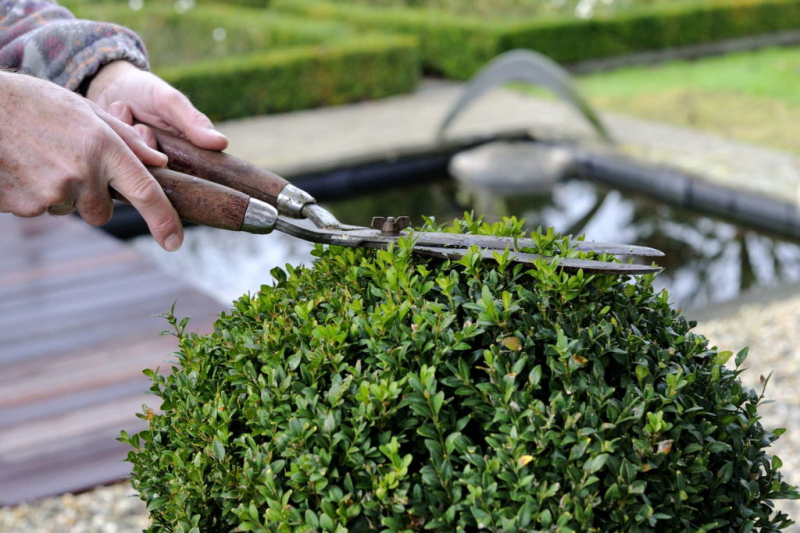
Water the boxwood
Since the box tree only has shallow roots, it cannot draw water from deeper soil layers. That is why he is dependent on regular watering when it is dry. With potted plants, you should take particular care that the soil does not dry out – even in winter. If you see brownish leaves and shoots after winter, this can be a sign of too much dryness in the cold season. In hot and dry summers, in particular, the box tree is happy to be showered with a hose or watering can so that dust is removed from the leaves.
Fertilize boxwood
Typical symptoms that your boxwood suffers from a lack of nitrogen are reduced growth and yellowish discoloration of the leaves. But to ensure that it doesn’t get that far, the box tree is dependent on regular fertilizers. The best time to fertilize is from spring to early summer. You should not fertilize later, however, as the shoots promoted by the fertilizer quickly die off in frost. For box trees, we recommend fertilizing with a fertilizer that has an organic long-term effect. An organic long-term fertilizer provides the plants with long-term nutrients and at the same time promotes healthy soil life and the build-up of humus.
Cut boxwood
The cut plays an important role in the boxwood: It promotes growth, the bushes become denser and lusher and the boxwood can be brought into the desired shape. You can cut between April and September. It is also important that the sun does not shine fully on the day of cutting and that it does not rain. Both hand scissors and electric scissors are suitable for cutting, but they should be sharp. Stencils can also help to bring the boxwood into the desired shape.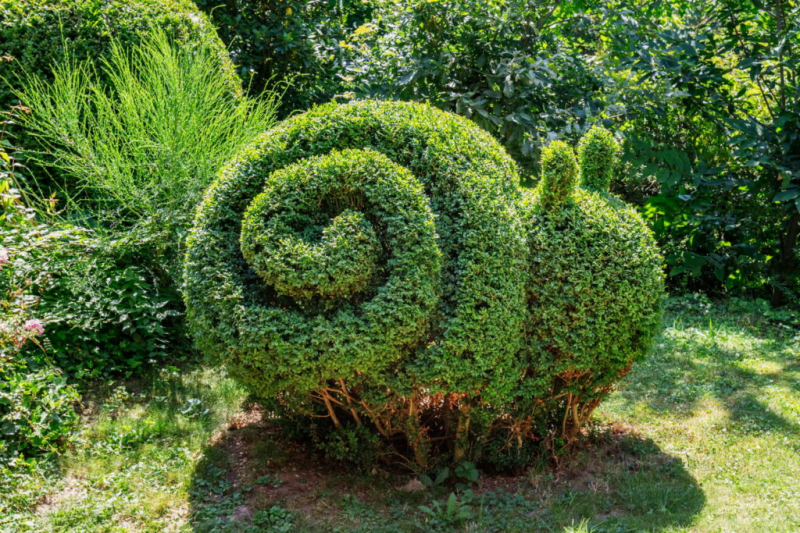
Hibernate boxwood
The box tree can survive our winters well in beds or as a hedge. It is different with box trees in pots. They are more delicate and require some measures to avoid freezing to death. If you can carry the pot, then simply put the boxwood somewhere sheltered from the wind, for example in front of a house wall. To protect the pot from the cold from below, it is best to place it on a wooden plate. If the pot is too big or too heavy to move, the bucket can also be protected from frost with jute sacks. On particularly cold days and nights, the boxwood itself can also be packed in the jute sacks. Don’t forget to water your boxwood regularly even in winter – but only on frost-free days.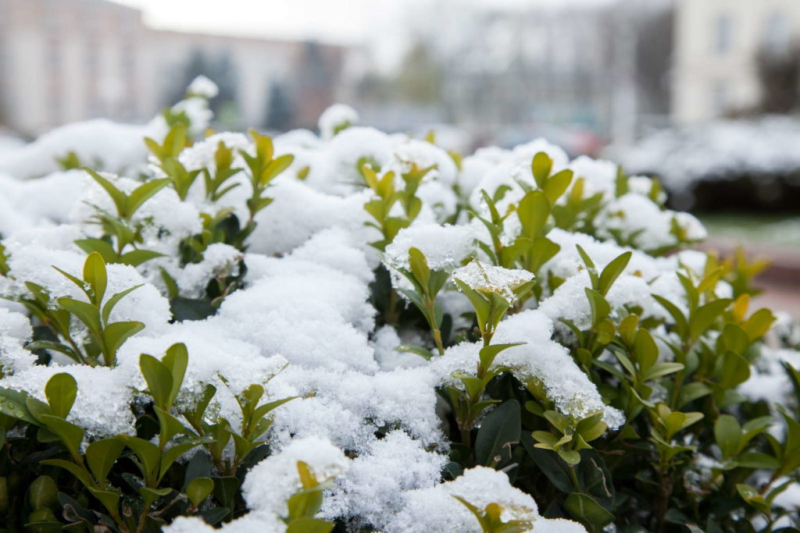
You can find out what damage frost can do to your boxwood and how you can prevent it in our special article on boxwood damage caused by environmental conditions.
Boxwood diseases
Unfortunately, some diseases do not stop at the box tree and can affect it very strongly. Here we give you a brief overview of the most important boxwood diseases.
Boxwood crab
The fungus Volutella buxi can penetrate the plant through the bark of the box tree and initially cause growths and later the death of shoots. If your boxwood is affected by cancer, you should cut back the infected parts and remove them.
Boxwood shoot death
Triggered by the fungus Cylindrocladium buxicola , the boxwood shoot death causes entire boxwoods to wither. The first signs of an infestation are brownish or orange spots on the leaves that keep getting bigger. Eventually, the bush sheds all of its leaves, and the shoots become bare. In the event of such an infestation, the only thing that helps is to remove the affected plants; alternatively, a pesticide can help.
Boxwood rust
Another disease caused by fungi is boxwood rust. Rust fungi usually color the leaves of the plant rust-red to brown. To combat it, the affected parts of the plant can simply be cut off and disposed of.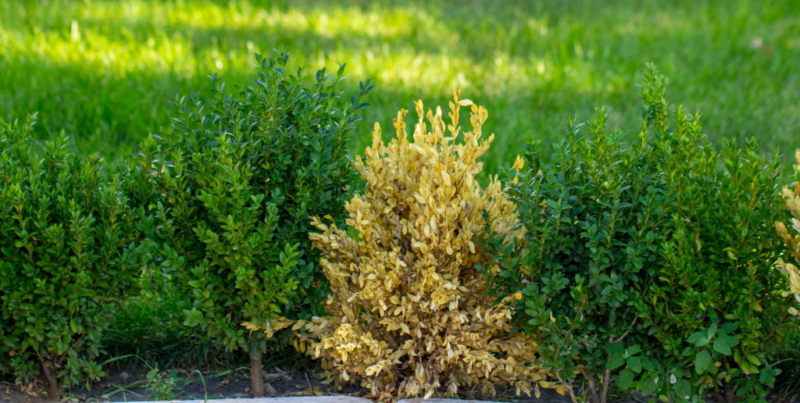
Boxwood pests
The most famous boxwood pest is probably the boxwood moth. But other pests can also taste the leaves of the bush. Here we introduce you to the most important boxwood pests.
Box tree moth
The caterpillars of the box tree moth (Cydalima perspectalis) have been eating holes in our box trees for several years. From mid-May, they will be up to mischief. You can find out how to get rid of the nuisance with tried and tested home remedies in our article Fighting the box tree moth with home remedies. If even these no longer help, we will give you further tips on how to control the box tree moth. We have put together for you all the important information on how to dispose of and handle the borer caterpillars.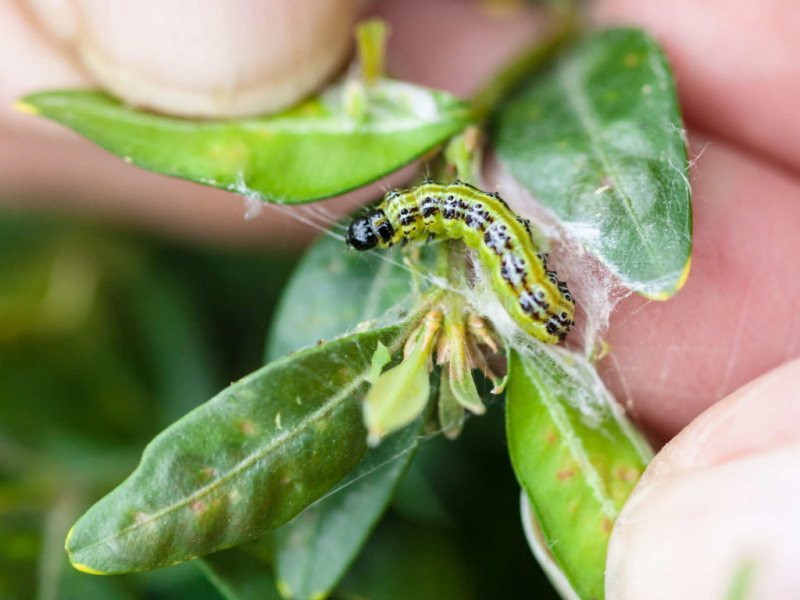
Shoot tip mite
Twisted shoots and leaves are caused by the shoot tip mite. This won’t harm your box tree, but it doesn’t look very nice. If you discover infected parts of the plant, cut back and remove them.
You might so like: Powdery Mildew On Roses: Identifying And Combating Powdery Mildew And Downy Mildew
Boxwood leaf flea
The boxwood flea can also taste the leaves of your bush. You can recognize the infestation on spoon-shaped, crooked leaves. Against the flea, it helps to cut off infected areas.
Boxwood: Toxic for humans and animals?
It is certainly safe for boxwood moths and co. To feed on the boxwood. For everyone else, however, the evergreen bush is highly toxic. This is due to the 70 different alkaloids in the roots and leaves of the plant. But since these taste very bitter and inedible, nobody will quickly get the idea to eat their fill.
 However, you should be careful with children, as even a small amount of the poison can have dire consequences with low body weight. So supervise young children in the garden and teach them not to eat the plant at an early age. So the beautiful bush can grow in your garden without posing any danger.
However, you should be careful with children, as even a small amount of the poison can have dire consequences with low body weight. So supervise young children in the garden and teach them not to eat the plant at an early age. So the beautiful bush can grow in your garden without posing any danger.


